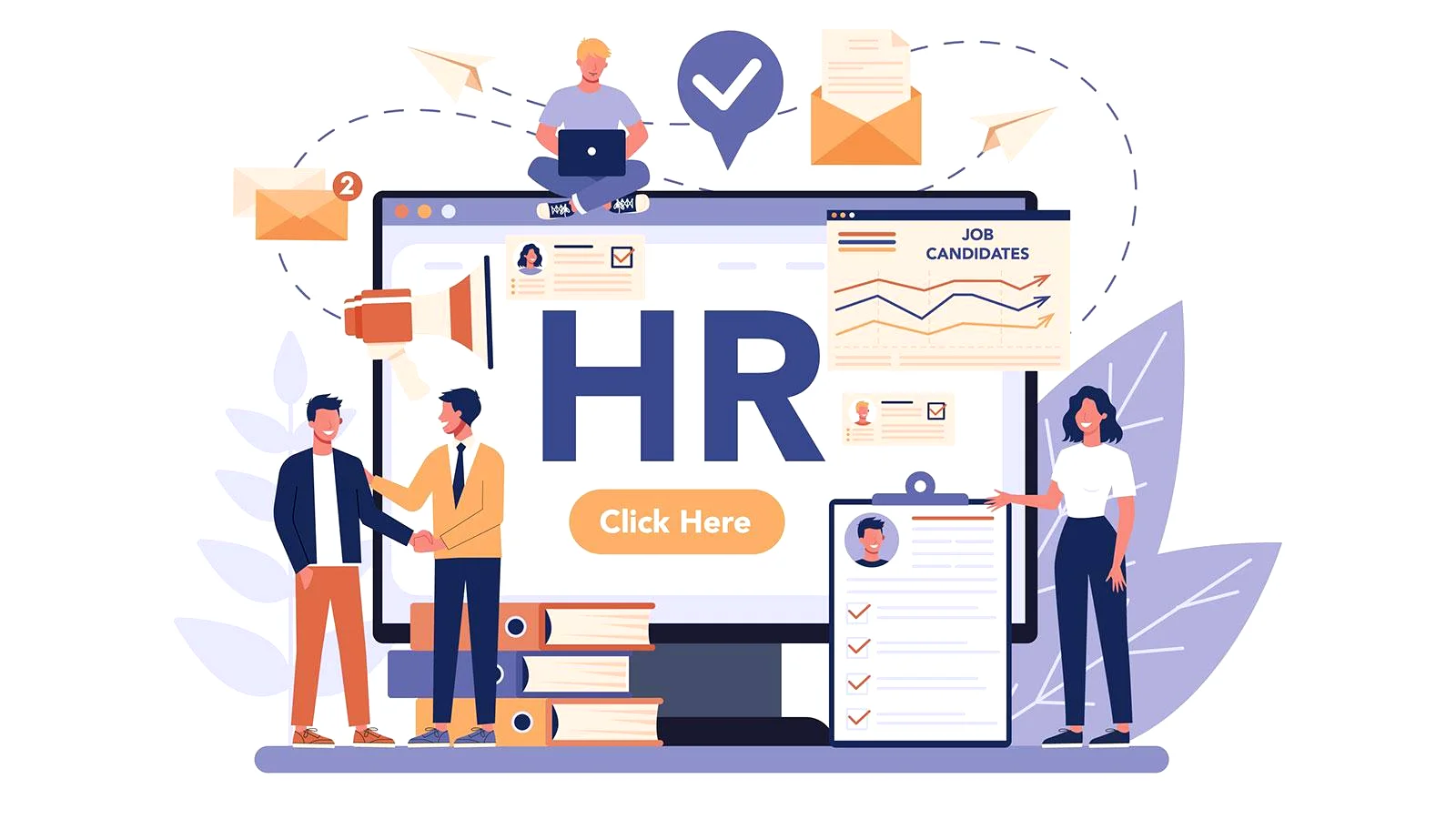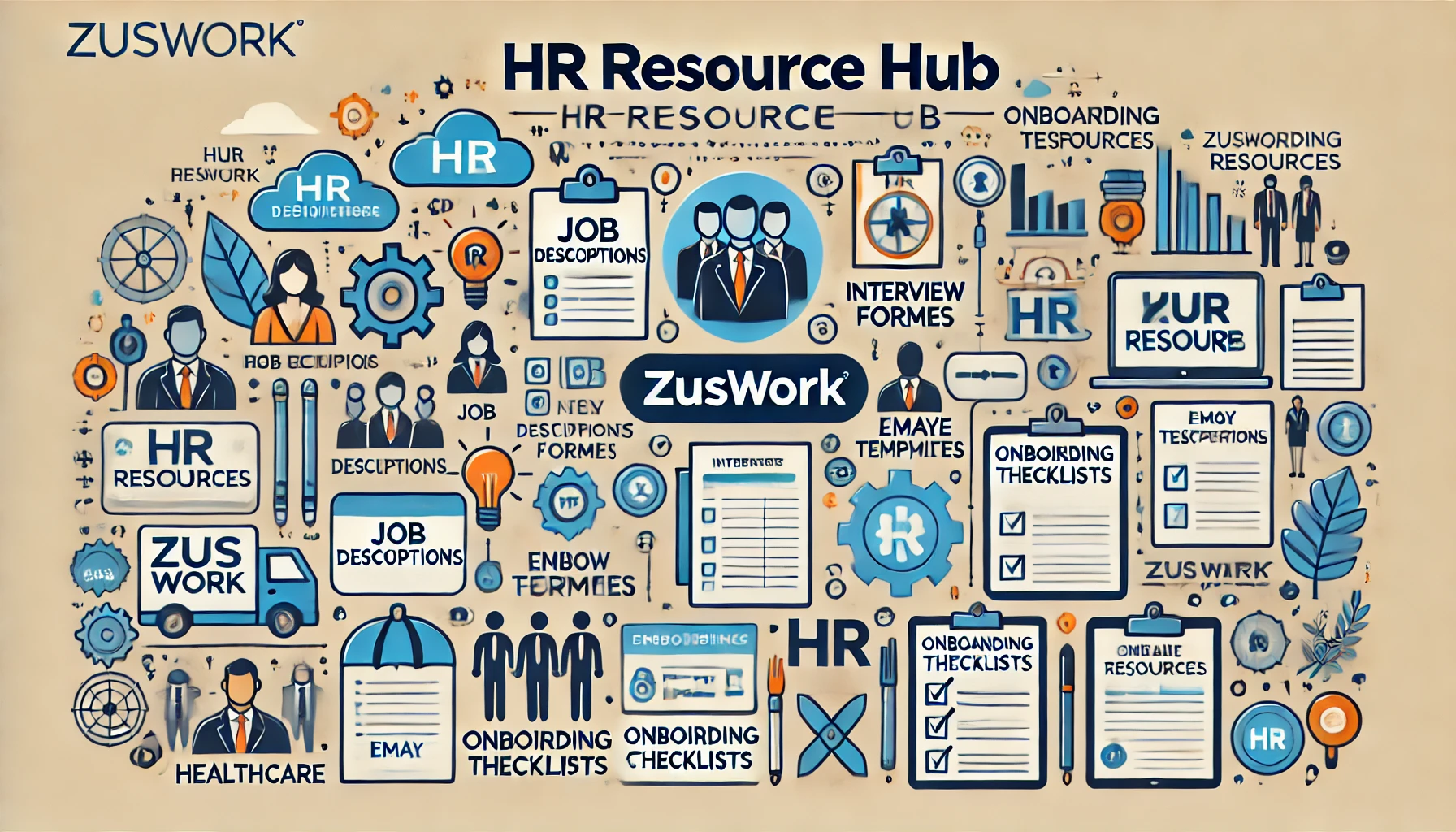ZusWork HR Resource Hub
Table of contents
- Welcome to Resource Hub
- Why choose Zuswork HR resource Hub
- Job Descriptions
- Why are job descriptions important?
- Purpose of job descriptions
- How job descriptions are written
- Benefits of Job descriptions
- Download Job description templates
- HR Email templates
- Reference Check form
- New hire onboarding checklist
- Candidate feedback survey
- Exit interview questionnaire
- Diversity and inclusion plan

Welcome to Zuswork's HR Resource Hub
At Zuswork, we understand the unique challenges faced by HR teams in healthcare, startups, and SaaS companies. Managing recruitment, employee engagement, and compliance can be overwhelming, especially with the fast-paced nature of these industries. From navigating complex regulatory environments in healthcare to scaling teams rapidly in startups and maintaining high levels of technical expertise in SaaS companies, the demands on HR teams are immense.
To support you in your mission to streamline HR processes and enhance your team’s efficiency, we offer a wide range of downloadable templates and resources. Our comprehensive collection includes job descriptions, interview evaluation forms, email templates, onboarding checklists, and more. These assets are designed to simplify your daily tasks, from recruitment to employee management, ensuring you have the tools needed to succeed.
Why Choose Zuswork’s HR Resource Hub?
- Extensive Template Library: Our HR Resource Hub features a vast array of templates tailored to the specific needs of healthcare, startup, and SaaS companies. Whether you need a detailed job description for a senior developer or an onboarding checklist for new hires, we have you covered.
- Compliance and Best Practices: All our templates are crafted by HR experts to ensure they meet the highest standards of legal compliance and best practices. This helps you stay compliant with industry regulations and standards, reducing risk and enhancing operational efficiency.
- Customizable and User-Friendly: Our templates are designed to be easily customizable, allowing you to tailor them to your specific organizational needs. This flexibility ensures that you can quickly adapt our resources to fit your unique HR processes.
- Cost-Effective Solutions: We provide both onshore and offshore options to meet your budget requirements without compromising on quality. Our solutions are designed to be cost-effective, helping you manage your HR operations efficiently.
- Streamlined HR Processes: Our ready-to-use templates save you time and effort, allowing you to focus on strategic HR activities. From recruitment and onboarding to employee engagement and compliance, our resources help streamline your HR processes.
Job Descriptions
Why Job Descriptions Are Important:
Job descriptions (JDs) are fundamental to the recruitment and management processes within any organization. They provide a clear and concise outline of the responsibilities, qualifications, and expectations associated with a specific role. Here’s why they are crucial:
- Clarity and Focus: JDs offer a detailed description of the job duties, which helps both the employer and the employee understand the expectations. This clarity is particularly important in startups where roles can be fluid and multi-faceted.
- Attracting the Right Candidates: By clearly outlining the skills, experience, and qualifications required, JDs help attract candidates who are genuinely suited for the role. This leads to better quality applications and a more efficient hiring process.
- Setting Performance Standards: JDs serve as a benchmark for evaluating employee performance. They provide a reference point for what is expected and can be used to measure an employee’s effectiveness and productivity.
- Legal Protection: Well-written JDs can protect companies legally by providing documented evidence of job requirements and expectations. This can be crucial in disputes over job performance or responsibilities.
- Facilitating Career Development: JDs can be used to identify career paths and development opportunities for employees, helping them understand what skills and experiences are needed for progression within the company.
Purpose of Job Descriptions:
- Defining Roles and Responsibilities: JDs define the tasks and responsibilities of a position, ensuring everyone in the organization understands what each role entails.
- Guiding Recruitment: They guide the recruitment process by providing a clear outline of what is needed in a candidate, making it easier to create job postings and assess applicants.
- Performance Management: JDs help in setting performance goals and conducting appraisals by outlining what is expected from an employee in their role.
- Compensation and Benefits: They aid in determining the appropriate compensation and benefits for a role based on its responsibilities and required qualifications.
- Workforce Planning: JDs assist in workforce planning by identifying the skills and qualifications needed for various roles, helping in strategic hiring and training decisions.
How Job Descriptions Are Written:
- Job Title and Summary: Begin with a clear job title and a brief summary that provides an overview of the role.
- Key Responsibilities: List the primary duties and responsibilities in order of importance. Be specific and use action verbs to describe tasks.
- Qualifications and Skills: Detail the required and preferred qualifications, including education, experience, technical skills, and soft skills.
- Working Conditions: Describe the working environment, including physical demands, work hours, and any special conditions.
- Reporting Structure: Specify who the employee will report to and who, if anyone, will report to them.
- Company Overview: Include a brief section about the company to give candidates context about the organization’s mission, culture, and values.
Benefits of Job Descriptions for Companies, Especially Startups:
- Improved Hiring Process: Startups can benefit significantly from clear JDs by attracting candidates who are not only skilled but also a good cultural fit.
- Enhanced Role Clarity: In a startup environment where roles can evolve, JDs provide clarity and help manage expectations as the company grows.
- Efficient Onboarding: Detailed JDs make the onboarding process smoother by giving new hires a clear understanding of their responsibilities from day one.
- Performance Management: JDs provide a framework for setting performance expectations and conducting evaluations, which is crucial for the growth and development of both the employees and the startup.
- Scalability: As startups grow, having well-defined JDs helps in scaling the team effectively, ensuring that each role is clearly understood and aligned with the company’s objectives.
By leveraging comprehensive job descriptions, startups can build a strong foundation for their recruitment and management processes, ultimately contributing to their long-term success.
Download Job description templates:
Following are the job description templates for download.
Job Description for Lead AR/VR developer
This job description template outlines the role of a Lead AR/VR Developer, responsible for developing and maintaining AR/VR applications for Android and iOS devices. It includes detailed responsibilities such as prototyping AR/VR products, optimizing mixed reality solutions, and collaborating with a team to ensure best practices. The role requires strong programming skills in C++, experience with AR/VR tools and platforms, and the ability to write clean, testable code.
Download Job Description for Lead AR/VR developer:
Job Description for AR/VR developer
This job description template is for an AR/VR Developer, highlighting the role’s focus on prototyping and building next-generation AR/VR products using Unity, Android, and iOS. It covers responsibilities such as developing high-quality interactive applications, optimizing mixed reality solutions, and collaborating on best practices. The role requires strong knowledge of AR/VR development tools, experience with 3D rendering engines, and proficiency in coding languages like React Native and Python.
Download Job Description for AR/VR developer:
Job Description for AR/VR Designer
This job description template is for an AR/VR Designer, emphasizing the need for a creative individual who can manage multiple projects, adhere to brand guidelines, and thrive in a fast-paced environment. Responsibilities include understanding user needs, conceptualizing and testing designs, translating concepts into prototypes, and managing projects within design specifications. The role requires professional experience in AR/VR design, a strong portfolio, proficiency with design tools like Figma and Photoshop, knowledge of 3D modeling and animation, and strong analytical and communication skills.
Download Job Description for AR/VR designer:
Job Description for Graphic Designer
This job description template is for a Graphic Designer, focusing on creating visually compelling designs while balancing multiple projects and adhering to brand guidelines in a fast-paced environment. Responsibilities include understanding user needs, conceptualizing and testing designs, translating concepts into prototypes, and managing design projects within specifications and budget constraints. The role requires professional experience in graphic design, a strong portfolio, proficiency with design tools like Sketch, Photoshop, and Figma, and a solid understanding of user-centered design practices. Key qualifications include relevant years of experience and strong analytical and communication skills.
Download Job Description for Graphic Designer:
Job Description for Android Imaging Expert
This job description template is for an Android Imaging Expert, responsible for developing vision aid solutions and ensuring the highest quality and performance of Android applications. The role involves supporting new product development, optimizing image quality, and leading a team to achieve project goals. Key skills include hands-on experience with Android native applications, camera HAL, image processing, low-level programming, and mobile graphics frameworks. A strong understanding of business requirements, proficiency in code versioning tools, and relevant professional experience are essential.
Download Job Description for Android Imaging Expert:
Job Description for Senior Mobile Developer (Algorithm Specialist)
This job description template is for a Senior Mobile Developer (Algorithm Specialist), focusing on developing vision care solutions and writing algorithms to solve real-world problems. The role involves supporting new product development, optimizing application performance, collaborating with the algorithms team, and integrating optimized algorithms into Java or Kotlin code. Key skills include experience with Android native applications, algorithm development, and proficiency in C/C++. Strong understanding of business requirements, offline storage, performance tuning, and knowledge of the open-source Android ecosystem are essential.
Download Job Description for Senior Mobile Developer (Algorithm Specialist):
Job Description for Content Writer
This job description template is for a Content Writer, responsible for enriching websites with blog posts, guides, and marketing materials. The role involves conducting thorough research on industry-related topics, generating new content ideas, and proofreading articles before publication. Key responsibilities include producing well-researched content, organizing writing schedules, collaborating with a content team, and utilizing SEO strategies to enhance online visibility. Essential skills include excellent writing proficiency, strong interpersonal skills, the ability to work independently, and proficiency with writing programs like Google Docs and Microsoft Word. A proven portfolio demonstrating writing expertise and familiarity with SEO best practices is required.
Download Job Description for Content Writer Template:
Job Description for Ecommerce Website Developer
This job description template is for an Ecommerce Website Developer, responsible for developing and maintaining responsive e-commerce websites using platforms like WordPress, Shopify, Magento, and WooCommerce. The role includes designing new functionalities, troubleshooting system issues, performing quality assurance tests, and ensuring security principles are applied to e-commerce applications. Key skills include full stack PHP web development, expertise in Magento and other frameworks, SEO knowledge, experience with responsive design, and proficiency in web services (REST/SOAP).
Download Job Description for an Ecommerce Website Developer Template:
Job Description for Head of Engineering
This job description template is for the Head of Engineering, responsible for leading agile software development teams with a focus on efficiency, scalability, and quality. The role involves managing engineering and QA managers, collaborating with product owners, sales teams, clients, and technology partners, and delivering high-quality products that scale to millions of users. Key responsibilities include developing and executing engineering strategies, architecting technology products, managing and inspiring teams, implementing new technologies, and ensuring alignment with business goals. Essential skills include strong knowledge of web or mobile development platforms, cloud-native applications, agile practices, and project management tools
Download Job Description for Head of Engineering Template:
Job Description for Engineering Manager
This job description template is for an Engineering Manager responsible for developing products, conducting market research, creating specifications, driving initiatives, and delivering high-quality products that scale to millions of users. The role includes leading cross-functional teams, developing marketing strategies, product launch plans, and programs. Key responsibilities involve managing the complete software development cycle, providing technical leadership, building scalable cloud-native applications, and mentoring team members. Essential skills include strong knowledge of web or mobile development platforms, project management tools, problem-solving, and proficiency in Agile and DevOps practices.
Download job description template for an Engineering Manager:
Job Description for Product Manager
This job description template is for a Product Manager responsible for developing products, conducting market research, generating product requirements, and driving initiatives. The role includes managing the product lifecycle from strategic planning to tactical activities, planning product launches, and leading cross-functional teams. Key responsibilities involve acting as a product champion, preparing and maintaining the product roadmap, and consulting with client services to ensure appropriate service levels. Essential skills include experience in product development, strong knowledge of development platforms and project management tools, excellent problem-solving abilities, and strong motivational and organizational skills.
Download job description template for a Product Manager:
Job Description for Product Owner
This job description template is for a Product Owner responsible for developing products, conducting market research, generating product requirements, determining specifications, driving initiatives, and delivering results. The role involves collaborating with engineers and developers, acting as a product champion, developing and executing the product roadmap, and working with clients and cross-functional teams. Key responsibilities include translating product features into requirements, prioritizing the sprint backlog, and turning data insights into actionable products. Essential skills include a balance of technical knowledge and business acumen, excellent communication, project management skills, and experience in Agile principles.
Download job description template for a Product Owner:
Job Description for Business Analyst
This job description template is for a Business Analyst who will join the product team to understand and translate business requirements into user stories, document processes, and perform user acceptance testing. The role involves working alongside product owners and business stakeholders, creating detailed business analyses, reports, and dashboards, and evaluating business processes to develop optimization strategies. Key responsibilities include writing user stories, producing business documents, analyzing data models, and overseeing the implementation of new technologies. Essential skills include strong communication, planning, analytical thinking, and proficiency in MS Office and JIRA.
Download the job description template for a Business Analyst:
Job Description for Operations Manager
This job description template is for an Operations Manager responsible for defining, implementing, and leading business process improvement and optimization for a fast-growing digital development agency. The role involves managing operational efficiency, resource planning, and support management, in collaboration with HR, Engineering, Product, Design, Sales, and Executive Leadership. Key responsibilities include planning and delivering projects, resource allocation, process development, client support, and administration of tools and processes. Essential skills include project management experience, knowledge of business and software development planning tools, strong communication and organizational abilities, and attention to detail.
Download the job description template for an Operations Manager:
Job Description for QA Engineer
This job description template is for a QA Engineer responsible for ensuring the timely and quality delivery of high-scale products. The role includes creating and implementing quality strategies, investigating product quality, managing quality planning, and collaborating with the Product Development team. Key responsibilities involve writing and reviewing testing plans, creating test automation procedures, identifying process improvements, and overseeing continuous improvement projects. Essential skills include a solid understanding of software testing, SQL, scripting, analytical and problem-solving abilities, and project management.
Download the job description template for a QA Engineer:
Job Description for React Native Developer
This job description template is for a React Native Developer responsible for developing cross-platform applications with a focus on high performance and quality. The role includes building smooth UIs for mobile platforms, leveraging native APIs, diagnosing and fixing bugs, maintaining code quality, and writing automated tests. Key responsibilities involve transitioning existing apps to React Native, unit testing, debugging, and deploying applications to the App Store and Play Store. Essential skills include experience with React Native, JavaScript, HTML/CSS, native Android/iOS development, and familiarity with tools like XCode, Android Studio, and back-end services like Firebase and AWS.
Download the job description template for a React Native Developer:
Job Description for Sr/Lead Technical Writer
This job description template is for a Sr/Lead Technical Writer responsible for creating and maintaining technical documentation for the engineering team and ensuring compliance with standards such as FDA, ISO, IEC, and HIPAA. The role involves developing and updating quality management systems, planning and creating technical documents, proofreading and editing, and collaborating with various teams to ensure compliance standards are met. Key responsibilities include understanding complex technical concepts, maintaining documentation standards, and supporting the team in adherence to compliance requirements. Essential skills include a thorough understanding of SDLC, experience in quality management systems and software testing, and excellent verbal and written communication skills.
Download the job description template for a Sr/Lead Technical Writer:
Job Description for Lead iOS Developer
This job description template is for a Senior/Lead iOS Developer responsible for developing and maintaining iOS applications and their integration with back-end services. The role includes translating designs into high-quality code, building and maintaining Swift code, ensuring application performance, and leading team members to achieve project goals. Key responsibilities involve identifying and fixing bugs, maintaining code quality, and optimizing application performance. Essential skills include a strong knowledge of iOS SDK, RESTful APIs, iOS UI design principles, offline storage, threading, performance tuning, and familiarity with code versioning tools and continuous integration.
Download the job description template for a Senior/Lead iOS Developer:
Job Description for Sr/Lead Android Developer
This job description template is for a Sr/Lead Android Developer responsible for developing and maintaining applications for diverse Android devices. The role involves translating designs into high-quality code, building and maintaining Java code, ensuring application performance, and leading team members to achieve project goals. Key responsibilities include identifying and fixing bugs, maintaining code quality, and optimizing application performance. Essential skills include strong knowledge of Android SDK, RESTful APIs, Android UI design principles, offline storage, threading, performance tuning, and familiarity with code versioning tools and continuous integration.
Download the job description template for a Sr/Lead Android Developer:
Job Description for Sr/Lead Full Stack Developer (MEAN/MERN)
This job description template is for a Sr/Lead Full Stack Developer (MEAN/MERN) responsible for developing and delivering high-quality web solutions that scale to millions of users. The role includes working closely with designers, product managers, and other developers, participating in business requirements gathering, and maintaining high-quality engineering standards. Key responsibilities involve building scalable user-facing products, performing unit testing, overseeing quality assurance, managing a team, and mentoring junior developers. Essential skills include experience with JavaScript technologies (MEAN, MERN), relational and non-relational databases, RESTful APIs, and Agile and DevOps practices.
Download the job description template for a Sr/Lead Full Stack Developer:
Job Description for Sr/Lead Front End Developer
This job description template is for a Sr/Lead Front End Developer responsible for developing excellent customer experiences and delivering high-quality, scalable web products. The role involves working closely with designers, product managers, and other developers, maintaining high-quality engineering standards, and performing unit testing and code reviews. Key responsibilities include developing and modifying code, building user-facing features, gathering business requirements, and mentoring junior team members. Essential skills include strong knowledge of modern JavaScript frameworks (React preferred), HTML5, CSS3, responsive design techniques, and version control with Git.
Download the job description template for a Sr/Lead Front End Developer:
Job Description for Sr/Lead Backend Developer (MEAN/MERN)
This job description template is for a Sr/Lead Backend Developer (MEAN/MERN) responsible for developing and maintaining backend services and infrastructure for scalable web applications. The role involves working closely with engineers, designers, product managers, and other stakeholders to deliver high-quality products. Key responsibilities include developing and optimizing server-side logic, integrating user-facing elements with backend services, implementing security and data protection measures, and designing data storage solutions. Essential skills include proficiency with JavaScript technologies (MEAN, MERN), experience with AWS or Azure, relational and non-relational databases, RESTful API development, and version control systems.
Download the job description template for a Sr/Lead Backend Developer (MEAN/MERN):
Job Description for Sr/Lead DevOps Engineer
This job description template is for a Sr/Lead DevOps Engineer responsible for establishing infrastructure and security practices, building scalable cloud infrastructure, implementing continuous integration, and training the team in DevOps best practices. Key responsibilities include automating infrastructure, implementing system health monitoring, building CI pipelines, providing Level 2 technical support, and developing scripts for automation. Essential skills include experience with cloud-based security solutions, server virtualization, infrastructure provisioning tools, scripting languages, Linux and Windows systems, continuous integration tools, and application server administration.
Download the job description template for a Sr/Lead DevOps Engineer:
Job Description for Ruby on Rails Developer (ROR)
This job description template is for a Ruby on Rails Developer responsible for developing and delivering scalable web solutions. The role includes writing clean, maintainable, and efficient code, designing robust features, contributing to all phases of the development lifecycle, creating back-end components, maintaining APIs, and ensuring the application follows best practices. Key responsibilities involve identifying and fixing bottlenecks, driving continuous adoption of new technologies, and working closely with other engineers and developers. Essential skills include hands-on experience with Ruby on Rails, knowledge of front-end technologies, relational and non-relational databases, RESTful API development, and Agile software development practices.
Download the job description template for a Ruby on Rails Developer:
Job Description for Sr Software Engineer, Middleware Integration Specialist
This job description template is for a Sr Software Engineer, Middleware Integration Specialist responsible for designing, developing, and testing middleware solutions that enable communication between proprietary software systems and third-party EHR systems. The role includes implementing data communication protocols such as HL7, FHIR, and DICOM, ensuring data privacy and security, and collaborating with product and engineering teams to align middleware solutions with overall product strategy. Key responsibilities involve understanding customer needs, troubleshooting middleware issues, and staying updated on middleware technologies. Essential qualifications include a Bachelor’s degree in Computer Science or a related field, relevant software development and middleware experience, proficiency in programming languages like JavaScript, Java, C#, or Python, and familiarity with cloud computing platforms and DevOps practices. Strong problem-solving, analytical, communication, and teamwork skills are required.
Download the job description template for a Sr Software Engineer, Middleware Integration Specialist:
HR Email templates
Our collection of HR email templates is designed to streamline and enhance your recruitment communication processes. These templates serve as ready-made solutions for various stages of candidate engagement, from initial outreach to interview confirmations. They are crafted to maintain professionalism, ensure consistency, and save time, allowing HR teams to focus more on strategic tasks rather than drafting emails from scratch. By using these templates, you can improve candidate experience, keep them informed and engaged, and ensure clear and efficient communication throughout the hiring process.
Download the candidate survey form:
- First touch source email
- Follow-up email for the past candidate: Are you still interested in the job
- Referral Email
- An application follow-up email to keep the candidate updated and warm
- Interview Invitation Email
- Interview Confirmation Email
- Interview Reminder Email
- Interview Follow-up Email
- Job Offer Email
- Rejection Email
Reference check form
The candidate survey form available in the Zuswork HR Resource Hub is designed to help companies gather essential feedback from job applicants about their recruitment and interview experiences. By downloading and utilizing this template, companies can gain valuable insights into the effectiveness of their hiring processes, identify areas for improvement, and ensure a positive candidate experience. This feedback helps HR departments understand candidates’ perceptions of their employer brand and the overall recruitment journey. Ultimately, using this form can lead to a more efficient and candidate-friendly hiring process, enhancing the company’s reputation and increasing the likelihood of attracting top talent in the future.
Download the candidate survey form:
New hire onboarding checklist
The new hire onboarding checklist template is designed to ensure a comprehensive and efficient onboarding process for new employees. By downloading and utilizing this template, companies can systematically track and complete all necessary steps to integrate new hires into the organization seamlessly. The checklist includes tasks such as completing paperwork, setting up workstations, providing access to necessary tools and systems, and conducting orientation sessions. Using this checklist helps HR departments ensure that no critical onboarding steps are overlooked, enhancing the new hire’s experience and helping them quickly become productive members of the team. This structured approach fosters better employee engagement and retention from day one.
Download the new hire onboarding checklist template:
Candidate feedback survey template
The candidate feedback survey template is a crucial tool provided in our HR resource hub to help companies continuously improve their recruitment and hiring processes. By gathering insights directly from candidates, organizations can identify strengths and weaknesses in their procedures, enhance the overall candidate experience, and bolster their employer brand. The purpose of these surveys is to evaluate the recruitment process, improve candidate experience, and inform hiring strategies. Utilizing candidate feedback surveys fosters a more transparent, efficient, and candidate-friendly hiring process, ultimately leading to better recruitment outcomes and a stronger employer brand.
Download the candidate feedback survey template:
Exit Interview questionnaire template
The exit interview questionnaire template provided in our HR resource hub is designed to help companies gather valuable insights from departing employees. By conducting exit interviews, organizations can understand the reasons behind employee turnover, identify areas for improvement within the workplace, and enhance overall employee satisfaction. The purpose of these questionnaires is to evaluate the employee’s experience, gather feedback on management and company policies, and uncover any underlying issues that may contribute to attrition. Utilizing exit interview questionnaires enables companies to make data-driven decisions to improve retention strategies and foster a more positive and productive work environment.
Download the exit interview questionnaire template:
Diversity and inclusion plan
The diversity and inclusion plan template available in our HR resource hub is designed to help companies develop comprehensive strategies for fostering an inclusive workplace. By implementing a diversity and inclusion plan, organizations can ensure they are creating an environment where all employees feel valued and respected, regardless of their background. The purpose of this template is to outline actionable steps for promoting diversity, equity, and inclusion within the company, from recruitment practices to employee development programs. Utilizing this plan enables companies to build a more diverse workforce, drive innovation, and improve overall employee satisfaction and engagement.
Download the diversity and inclusion plan template:
The diversity and inclusion plan template available in our HR resource hub is designed to help companies develop comprehensive strategies for fostering an inclusive workplace. By implementing a diversity and inclusion plan, organizations can ensure they are creating an environment where all employees feel valued and respected, regardless of their background. The purpose of this template is to outline actionable steps for promoting diversity, equity, and inclusion within the company, from recruitment practices to employee development programs. Utilizing this plan enables companies to build a more diverse workforce, drive innovation, and improve overall employee satisfaction and engagement.










